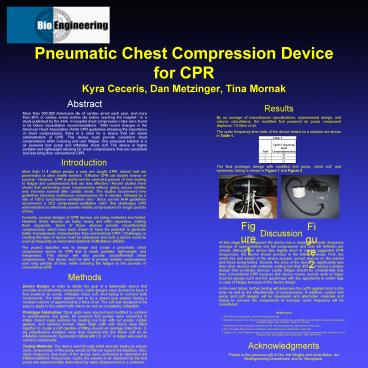Abstract - PowerPoint PPT Presentation
1 / 1
Title:
Abstract
Description:
Pneumatic Chest Compression Device for CPR Kyra Ceceris, Dan Metzinger, Tina Mornak Abstract More than 300,000 Americans die of cardiac arrest each year, and more ... – PowerPoint PPT presentation
Number of Views:47
Avg rating:3.0/5.0
Title: Abstract
1
Pneumatic Chest Compression Device for CPRKyra
Ceceris, Dan Metzinger, Tina Mornak
- Abstract
- More than 300,000 Americans die of cardiac arrest
each year, and more than 95 of cardiac arrest
victims die before reaching the hospital.1 In a
study published by the AHA, in-hospital chest
compression rates were found to be below
resuscitation recommendations.1 With recent
changes in the American Heart Association (AHA)
CPR guidelines stressing the importance of chest
compressions, there is a need for a device that
can assist administrators of CPR. This device
must provide consistent chest compressions while
reducing end user fatigue. One proposed solution
is a air powered foot pump and inflatable chest
cuff. The device is highly portable and
lightweight allowing for chest compressions that
are consistent and less tiring then conventional
CPR.
Results By an average of manufacturer
specifications, experimental design, and volume
calculations, the modified foot powered air pump
component displaces 1.9 liters of air. The
cyclic frequency time trials of the device tested
on a manikin are shown in Table 1. The final
prototype design with modified foot pump, chest
cuff, and systematic tubing is shown in Figure 1
and Figure 2
Introduction More than 11.4 million people a year
are taught CPR almost half are paramedics or
other health workers.1 Effective CPR can double
chance of survival.1 However, CPR is performed
for extended periods of time leading to fatigue
and compressions that are less effective.2 Recent
studies have shown that performing chest
compressions without giving rescue breaths may
increase survival after cardiac arrest. The
studies recommend new guidelines stressing
continuous compressions for 4 minutes, followed
by a rate of 1002 compression-ventilation
ratio.3 Since current AHA guidelines recommend a
302 compression-ventilation ratio4, this
challenges CPR administrators to effectively
provide reliable compressions for longer periods
of time. Currently, several designs of CPR
devices are being marketed and tested. However,
these devices are bulky, heavy, and often
expensive, making them unpopular. Some of these
devices provide circumferential compressions,
which have been shown to have the potential to
generate better hemodynamic characteristics than
conventional CPR.5 Challenges in creating this
type of device must be addressed and such a
device could be used as frequently as Automated
External Defibrillators (AEDs). The project
objective was to design and create a pneumatic
chest compression device for CPR that is small,
portable, light-weight, and inexpensive. This
device will also provide circumferential chest
compressions. This device must be able to provide
reliable compressions over long periods of time,
while reducing the fatigue in the provider of
conventional CPR.
Figure 1
Figure 2
Discussion At this stage in development the
device has a respectable cyclic frequency average
of approximately one full compression and near
full deflation per minute. Although the device
falls slightly short of current suggested CPR
frequencies, the device shows promise in the
following areas. First, the small size and weight
of the device surpass current devices on the
market and those being tested. Second, the price
of the device is significantly less than other
devices with materials costing less than 55 and
having a simpler design than predicate devices.
Lastly, fatigue should be considerably less than
conventional CPR because this device moves muscle
work to larger muscles groups such and the
quadriceps with the opportunity to switch legs in
case of fatigue because of the device design. In
the near future, further testing will determine
the cuffs applied force to the torso as well as
the effectiveness of compressions. In addition,
custom foot pump and cuff designs will be
developed and alternative materials and tubing to
connect the components to increase cyclic
frequency will be considered.
Methods Device Design In order to obtain the
goal of a lightweight device that provides
circumferential compression, initial designs were
devised to have a foot powered air pump,
inflatable chest cuff, and tubing to connect both
components. The entire system was to be a closed
loop system having a constant volume of
approximately 2 liters of air. The cuff was
designed to be easy to apply to the patient with
Velcro as well as completely collapsible Prototype
Fabrication Stock parts were sourced and
modified to conform to specifications and goals.
Air powered foot pumps were converted to inflate
closed loops systems by sealing one hole with cut
acrylic, rubber gaskets, and machine screws.
Nylon thigh cuffs with Velcro were fitted
together to create a cuff capable of fitting
around an average male torso. 3-ply polyethylene
bladders were then inserted into the Nylon cuff
as an inflatable component. Systematic tubing
with I.D. of ¼ or larger was used to connect
components. Testing Methods The device went
through initial strength testing to ensure cyclic
compression of the pump would not fail nor
rupture the bladders. Also, cyclic frequency time
tests of the device were performed to determine
full inflation/deflation frequencies. Lastly, the
volume of air displaced by the foot pump was
experimentally determined by water displacement
in a container.
References 1. AHA CPR Facts and Statistics.
http//www.americanheart.org/ 2. Abella BS,
Sandbo N, et al. Chest compression rates during
cardiopulmonary resuscitation are suboptimal a
prospective study during in-hospital cardiac
arrest. Circulation. 2005 111 428434. 3. 2005
American Heart Association Guidelines for CPR.
http//circ.ahajournals.org/content/vol112/24_supp
l/ 4. CPR Instructions Should Focus On Continuous
Chest Compressions. Science Daily. 6 May 2005.
5. Halperin, H.R., et al. A Preliminary Study of
Cardiopulmonary Resuscitation by Circumferential
Compression of the Chest with Use of a Pneumatic
Vest. New England Journal of Medicine. 1993
329762-768.
Acknowledgments Thanks to the generous gift of
Drs. Hal Wrigley and Linda Baker, the
BioEngineering Department, and Dr. Menegazzi.































